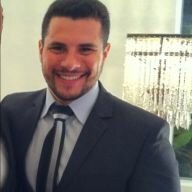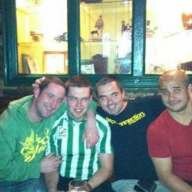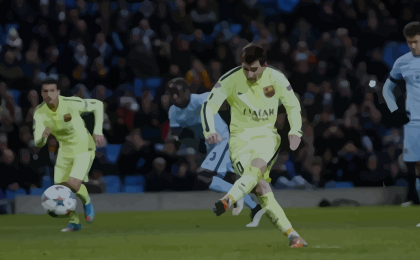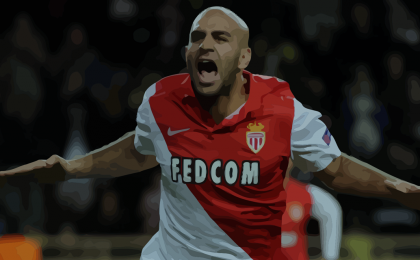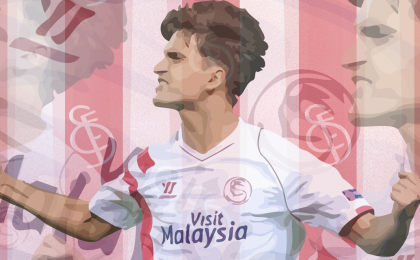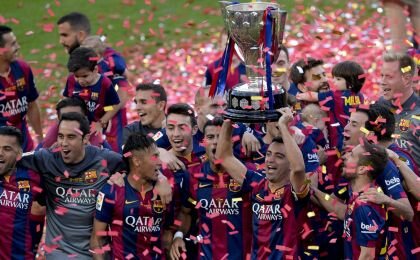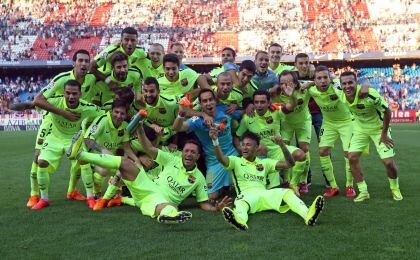 specials | 2015-08-01
specials | 2015-08-01
The Brazilians of FC Barcelona - Part Four
The modern day heroes
The fashionable lightning bolt
Unlike what happens with most Brazilian players who go to Europe, Daniel Alves left as a young man from Bahía and not from one of the big southeastern teams. He arrived at Sevilla and for six years formed a great team with the likes of Kanouté, Luis Fabiano, and Adriano, winning two Europa Leagues, one Copa del Rey, one Spanish Super Cup, and one European Super Cup.
In his last two years at Sevilla he was constantly having words with the controversial president Del Nido about his transfer. On various occasions, he was close to signing for Chelsea and Liverpool, but finally he came to an agreement with the president. He would play for Sevilla for one more year and would leave for Barcelona in exchange for €35 million, the biggest transfer fee in the club’s history.
It’s very clear that Daniel Alves is more than a defender. From his first season, a devastating partnership was formed with Leo Messi on the right wing of the culé attack. He has a fantastic engine, as dangerous in attack as he is attentive in defense, although in the last few seasons his defending has left quite a bit to be desired, especially with aerial balls.
He is one of Barça’s most successful Brazilian players both in terms of silverware and the fact that he was an undisputed starter in what many consider as the best team ever seen in football history. He has four La Ligas (2009, 2010, 2011 and 2013), two Champions Leagues (2009 and 2011), two Copas del Rey (2009 and 2012), three Spanish Super Cups (2009, 2010, 2011 and 2013), two UEFA Super Cups (2009 and 2011) and two Club World Cups (2009 and 2011).
Right now, Dani’s future is unknown. His contract is running out and he could have made a deal with any team he wished to, but he decided to wait for the club. Let’s see what the future holds for this legendary Brazilian culé.
The versatile man made of crystal
FC Barcelona signed Adriano Correia in the 2010-11 season. Just like Dani Alves, he came to the club after six successful years at Sevilla, the only difference being that he would play on the left side of defense.
After a timid season in which he took time to adapt to the blaugrana style of play, Adriano began to have more opportunities in the 2011-12 season, especially after Eric Abidal’s health problems. In the 2012-13 season he was used quite often and, in his three years at the club he has played in every position imaginable, apart from goalkeeper and center forward. Adriano is an excellent professional who, because of his pace, vision, anticipation, and comfort using either foot, has always been extremely useful for FC Barcelona, whether as a starter or a substitute.
He has now played more than 100 games at the club, winning two La Liga (2011 and 2013), one Copa del Rey (2012), two Spanish Super Cups (2010 and 2011), one Champions League (2011), one UEFA Super Cup (2011) and one Club World Cup (2011).
Maxwell was here! For a while.
Maxwell was signed from Inter Milan with his favorite person alive, Zlatan Ibrahimovic, in the 2009-2010 season.
The player didn’t play much and never impressed. Most fans remember him more for his hair than his actual abilities. A Brazilian player that ended up being nothing more than a bonus signing by his agent Mino Raiola.
Thiago Alcântara, the shunned heir
Thiago Alcântara, Mazinho’s elder son, was one of the most promising players La Masia ever produced: A complete midfielder, with vision, decent pace, and an impressive dribbling ability. The man walked differently than most players. Touched the ball differently. One of the chosen ones.
But he left.
Thiago Alcântara didn’t leave FC Barcelona because he wanted more playing time, or because he couldn’t wait to be a starter. He wasn’t a traitor who even considered going to Real Madrid. He was pushed out of the club.
And he was pushed out for the lowest price Barcelona could contractually sell him. And no, Bayern didn’t pay €25 million for him, as our club website gladly stated: It was only €20 million, plus €1 million paid on that friendly we had against Bayern before the 2013-14 season. The other €4 million is counted from the salary Thiago waived to sign with Bayern.
And why did that happen? Why would a club like FC Barcelona, who has been depending on good midfielders since 1988, sell one of the most promising players in Europe?
Well, money. They wanted to sign Neymar. At all costs, as you can see here: The Neymar Case Explained, and needed some green numbers on that year’s financial report.
That little story that “Tito and the staff forgot he had to play a certain amount of minutes to activate his €90-million-clause” was a straight up lie. Thiago Alcântara’s case might become the crowning jewel of that board’s sporting failure, and Bayern Munich were lucky enough to pounce and aside from unfortunate injuries, he's been one of their best and most decisive players.
Neymar, the great prospect
The biggest prospect from Brazilian football in the last several years came from Pelé’s team; Neymar won several Paulistão titles (regional tournament), one Brazilian Cup and his most important title so far: One Libertadores title, where he was the best player of the tournament and even scored in the final.
His history with FC Barcelona started in November 2011, when he signed a pre-contract with us, in a financial engineering scheme that would lead to the fiscal fraud case we are witnessing now, and which Grup has previously discussed about at length here: The Neymar Case Explained.
So he played the Club World Cup final having already signed a pre-deal with FC Barcelona, and couldn’t have helped Santos anyway, when they were crushed 4-0 by one of the best Guardiola-era displays.
He arrived in 2013-14, and suffered greatly to fit into the team. Then-coach Tata Martino didn’t help. But Neymar had, and still has, some bad habits acquired in Brazilian football: Holding onto the ball too much, stopping to dribble instead of keeping the play going, and the occasional diving. The team as a whole suffered under Tata Martino primarily because of the stagnant playing style he tried to apply, so Neymar had a regular season, at best.
In 2014-15 we are seeing a much better version of Neymar. Under Luis Enrique’s direct playing style that heavily relies on the forwards, Neymar, by April, has scored 30 goals, and has especially shone on big matches. Some of his old habits still remain, but we are finally seeing his true potential.
Like Romário, Ronaldo, Rivaldo, and Ronaldinho, Neymar has the keys to the Kingdom. It’s up to him to be focused enough and smart enough to reach his full potential and, one day, keep the trend going and become the fifth Brazilian player to win a Ballon d’Or as an FC Barcelona player.
Douglas, the biggest of jokes
The summer of 2014-15 was different for FC Barcelona. FC Barcelona knew it was not going to be able to sign player until January 2016, so the club had to sign well. Extremely well. And even though Barcelona did sign the likes of Ter Stegen who came earlier, Bravo, Rakitic, and the marvelous Luis Suárez, we also brought a player no one in Brazil ever rated as good, let alone good enough, for European football: Douglas Pereira dos Santos.
This writer gets to talk about Douglas for one simple reason: He was born on the same state as I was, and played several seasons in my home team. He has always been the type of player who makes fans mad. Too abrupt, too weak in defending, can’t keep his head up while running, put simply, an average player in an average league.
He did play for São Paulo, one of the biggest Brazilians teams, but has always been attacked viciously by the fans. Not nearly good enough, but given how right back is a very hard position to fill, he persevered. People forget that most big Brazilians teams have average squads and players, too. It’s a broken “league”, with teams that have racked up over $4 billion in debts.
And then, the business of the century was done: The same people who had brought Keirrison and Henrique to FC Barcelona – players who have never played a second in our colors – now made Douglas, a player no one ever mentioned as good enough to play for the Brazilian NT, become an FC Barcelona player.
FC Barcelona became a joke in Brazil. Douglas didn’t come because of his abilities nor potential. It was a shady deal done by one of Zubizarreta’s assistants, and the player won't ever reach double digits in appearances for Barcelona.
He will leave by the back door, loaned indefinitely around Europe until his contract runs out and he comes back to some middle-table team in Brazil. Like Rochemback, he will be remembered as the kind of Brazilian player we should have never signed in the first place.
Rafinha, the brother
Luckily for Barcelona, Rafinha wasn’t sold and only loaned during the 2013-14 season to Celta, where he had his breakthrough season, named the best young player and was a revelation of that La Liga season.
Luis Enrique brought him back to the club for the 2014-15 season, and Rafinha has been getting his fair share of minutes.
His style is different than that of the classic Masia graduate, but his pace, work rate, passing, dribbling, and vision fit well under Luis Enrique’s more vertical style.
Rafinha’s versatility is his best quality. He can play as a left center midfielder, right center midfielder, center attacking midfielder, and even right wing midfielder. He will need more minutes and a long stretch of games to allow us to see his full potential, but the future is bright.
We pushed his brother away, but Rafinha Alcântara has everything to become the first Brazilian La Masia player to shine for our club, making this rich history between FC Barcelona and Brazil reach its full circle: Brazil’s production of players has been in decline for over a dozen years, so the best academy in Europe is now developing great Brazilian players to serve the Brazilian NT.
Read the first part The Brazilians of FC Barcelona - Part One, the second part The Brazilians of FC Barcelona - Part Two and the third part The Brazilians of FC Barcelona - Part Three of the series.



